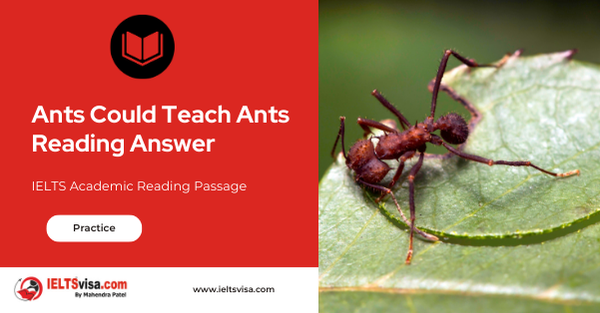Ants Could Teach Ants Reading Answer
IELTS Academic Reading Passage
The ants are tiny and usually nest between rocks in the south coast of England. Transformed into research subjects at the University of Bristol, they raced along a tabletop foraging for food -and then, remarkably, returned to guide others. Time and again, followers trailed behind leaders, darting this way and that along the route, presumably to memorize land- marks. Once a follower got its bearings, it tapped the leader with its antennae, prompting the lesson to literally proceed to the next step. The ants were only looking for food but the researchers said the careful way the leaders led followers -thereby turning them into leaders in their own right -marked the Temnothorax albipennis ant as the very first example of a non-human animal exhibiting teaching behavior.
“Tandem running is an example of teaching, to our knowledge the first in a non-human animal, that involves bidirectional feedback between teacher and pupil,” remarks Nigel Franks, professor of animal behavior and ecology, whose paper on the ant educators was published last week in the journal Nature.
No sooner was the paper published, of course, than another educator questioned it. Marc Hauser, a psychologist and biologist and one of the scientists who came up with the definition of teaching, said it was unclear whether the ants had learned a new skill or merely acquired new information.
Later, Franks took a further study and found that there were even races between leaders. With the guidance of leaders, ants could find food faster. But the help comes at a cost for the leader, who normally would have reached the food about four times faster if not hampered by a follower. This means the hypothesis that the leaders deliberately slowed down in order to pass the skills on to the followers seems potentially valid. His ideas were advocated by the students who carried out the video project with him.
Opposing views still arose, however. Hauser noted that mere communication of information is commonplace in the animal world. Consider a species, for example, that uses alarm calls to warn fellow members about the presence of a predator. Sounding the alarm can be costly, because the animal may draw the attention of the predator to itself. But it allows others to flee to safety. “Would you call this teaching?” wrote Hauser. “The caller incurs a cost. The naive animals gain a benefit and new knowledge that better enables them to learn about the predator’s location than if the caller had not called. This happens throughout the animal kingdom, but we don’t call it teaching, even though it is clearly transfer of information.”
Tim Caro, a zoologist, presented two cases of animal communication. He found that cheetah mothers that take their cubs along on hunts gradually allow their cubs to do more of the hunting -going, for example, from killing a gazelle and allowing young cubs to eat to merely tripping the gazelle and letting the cubs finish it off. At one level, such behavior might be called teaching -except the mother was not really teaching the cubs to hunt but merely facilitating various stages of learning. In another instance, birds watching other birds using a stick to locate food such as insects and so on, are observed to do the same thing themselves while finding food later.
Psychologists study animal behavior in part to understand the evolutionary roots of human behavior, Hauser said. The challenge in understanding whether other animals truly teach one another, he added, is that human teaching involves a “theory of mind” -teachers are aware that students don’t know something. He questioned whether Franks’s leader ants really knew that the follower ants were ignorant. Could they simply have been following an instinctive rule to proceed when the followers tapped them on the legs or abdomen? And did leaders that led the way to food -only to find that it had been removed by the experimenter -incur the wrath of followers? That, Hauser said, would suggest that the follower ant actually knew the leader was more knowledgeable and not merely following an instinctive routine itself.
The controversy went on, and for a good reason. The occurrence of teaching in ants, if proven to be true, indicates that teaching can evolve in animals with tiny brains. It is probably the value of information in social animals that determines when teaching will evolve rather than the constraints of brain size.
Bennett Galef Jr., a psychologist who studies animal behavior and social learning at McMaster University in Canada, maintained that ants were unlikely to have a “theory of mind” -meaning that leader and followers may well have been following instinctive routines that were not based on an understanding of what was happening in another ant’s brain. He warned that scientists may be barking up the wrong tree when they look not only for examples of humanlike behavior among other animals but humanlike thinking that underlies such behavior. Animals may behave in ways similar to humans without a similar cognitive system, he said, so the behavior is not necessarily a good guide into how humans came to think the way they do.
Questions 1-5
Look at the following statements (Questions 1-5) and the list of people in the box below. Match each statement with the correct person, A, B, C or D.
Write the correct letter, A, B, C or D, in boxes 1-5 on your answer sheet.
NB You may use any letter more than once.
1……………….. Animals could use objects to locate food.
2……………….. Ants show two-way, interactive teaching behaviors.
3……………….. It is risky to say ants can teach other ants like human beings do.
4……………….. Ant leadership makes finding food faster.
5…………………Communication between ants is not entirely teaching.
List of People
A. Nigel Franks
B. Marc Hauser
C. Tim Caro
D. Bennett Galef Jr.
Questions 6-9
Choose FOUR letters, A-H
Write your answers in boxes 6-9 on your answer sheet.
Which FOUR of the following behaviors of animals are mentioned in the passage?
A. touch each other with antenna
B. alert others when there is danger
C. escape from predators
D. protect the young
E. hunt food for the young
F. fight with each other
G. use tools like twigs
H. feed on a variety of foods
Questions 10-13
Do the following statements agree with the claims of the writer in Reading Passage?
In boxes 10-13 on your answer sheet, write
YES if the statement agrees with the claims of the writer
NO if the statement contradicts the claims of the writer
NOT GIVEN if it is impossible to say what the writer thinks about this
10 Ants’ tandem running involves only one-way communication.
11 Franks’s theory got many supporters immediately after publicity.
12 Ants’ teaching behavior is the same as that of human.
13 Cheetah share hunting gains to younger ones

Solution:Ants Could Teach Ants Reading Answer
| 1. C | 8. A,B,E,G IN ANY ORDER |
| 2. A | 9. A,B,E,G IN ANY ORDER |
| 3. D | 10. NO |
| 4. A | 11. NOT GIVEN |
| 5. B | 12. NOT GIVEN |
| 6. A,B,E,G IN ANY ORDER | 13. YES |
| 7. A,B,E,G IN ANY ORDER |
Review and Practice
- Regularly practice with IELTS reading samples and time yourself to get used to the pressure of the exam.
- Review your mistakes to understand where you went wrong and how to avoid similar errors in the future.
Our Books
Master IELTS Speaking Part 1
IELTS Writing Task 1 Book
IELTS Writing Task 2 Book
Ants Could Teach Ants Reading Answer Explanation
| Question NO | Question Type | Answer | Keywords | Supporting Sentence | Location of Keywords | Explanation |
|---|---|---|---|---|---|---|
| 1 | List of People | C | locate food | “In another instance, birds watching other birds using a stick to locate food such as insects and so on, are observed to do the same thing themselves while finding food later.” | Section F, 5th line | Tim Caro presented cases depicting animal communication, where birds use tools like sticks to find food by observing others. |
| 2 | List of People | A | bidirectional feedback, teaching | “Tandem running is an example of teaching, to our knowledge the first in a non-human animal, that involves bidirectional feedback between teacher and pupil,” remarks Nigel Franks. | Section B, 2nd line | Nigel Franks highlighted a teaching method involving two-way feedback between teacher and pupil ants during tandem running. |
| 3 | List of People | D | humanlike behaviour, cognitive system | “He warned that scientists may be barking up the wrong tree when they look not only for examples of humanlike behaviour among other animals but humanlike thinking that underlies such behaviour.” | Section I, 7th line | Bennett Galef Jr stated that animals may show human-like behaviour but lack a similar cognitive system, cautioning against overinterpretation. |
| 4 | List of People | A | find food faster, guidance | “With the guidance of leaders, ants could find food faster. But the help comes at a cost for the leader.” | Section D, 2nd line | Nigel Franks found that leader ants help others find food faster, although it slows the leader down. |
| 5 | List of People | B | transfer of information, not teaching | “The naive animals gain a benefit and new knowledge that better enables them to learn about the predator’s location than if the caller had not called. This happens throughout the animal kingdom, but we don’t call it teaching.” | Section E, last line | Marc Hauser described animal communication as information transfer, not necessarily teaching, even if it involves warning calls. |
| 6 | Choose FOUR letters | A | antenna, tap | “Once a follower got its bearings, it tapped the leader with its antennae, prompting the lesson to proceed.” | Section A, 4th line | Ants use their antennae to tap each other, indicating communication during learning. |
| 7 | Choose FOUR letters | B | warn, alarm, predator | “Sounding the alarm can be costly, because the animal may draw the attention of the predator to itself.” | Section E, 2nd line | Animals warn others of predators through alarm calls, even at personal risk. |
| 8 | Choose FOUR letters | E | hunt, cubs | “Cheetah mothers take their cubs on hunts, gradually allowing them to do more of the hunting.” | Section F, 2nd line | Cheetah mothers train their cubs by letting them participate in hunting activities. |
| 9 | Choose FOUR letters | G | stick | “Birds using a stick to locate food are observed to do the same thing themselves later.” | Section F, 5th line | Birds imitate others using sticks as tools to find food, showing observational learning. |
| 10 | True / False / Not Given | C | bidirectional feedback | “Tandem running involves bidirectional feedback between teacher and pupil.” | Section B, 1st line | According to Nigel Franks, tandem running in ants involves two-way communication, making the statement false if one-way communication is implied. |
| 11 | True / False / Not Given | Not Given | – | – | – | No specific information available. |
| 12 | True / False / Not Given | Not Given | – | – | – | No specific information available. |
| 13 | True / False / Not Given | Yes | Cheetah, cubs, hunting | “Cheetah mothers allow their cubs to trip a gazelle and let them finish it off.” | Section F, 1st line | Tim Caro explains how cheetah mothers teach their cubs hunting skills by allowing them to participate in kills, supporting a ‘Yes’ response. |
Practice IELTS Other Modules
IELTS Listening
The IELTS Listening test assesses how well you can understand spoken English in various contexts. It lasts about 30 minutes and is divided into four sections with a total of 40 questions. The listening tasks become increasingly difficult as the test progresses.
IELTS Academic Reading
The IELTS Academic Reading section assesses your ability to understand and interpret a variety of texts in academic settings. It is designed to evaluate a range of reading skills, including skimming for gist, reading for main ideas, reading for detail, understanding inferences, and recognizing a writer's opinions and arguments.
IELTS Speaking
The IELTS Speaking test assesses your ability to communicate in English on everyday topics. It lasts 11-14 minutes and consists of three parts: introduction, cue card, and a discussion based on the cue card topic.
IELTS General Reading
IELTS General Reading tests your ability to understand and interpret various types of texts. Here are some key areas and types of content you can expect to encounter in the reading section, along with tips for effective preparation.
IELTS Academic Writing Task 1
In IELTS Academic Writing Task 1, you are presented with a visual representation of information, such as graphs, charts, tables, or diagrams, and you are required to summarize, compare, or explain the data in your own words.
IELTS General Writing Task 1
In IELTS General Writing Task 1, you are required to write a letter based on a given situation. The letter can be formal, semi-formal, or informal, depending on the prompt. Here’s a breakdown of the key components to include in your letter
IELTS Academic Writing Task 2
In IELTS Academic Writing Task 2, you are required to write an essay in response to a question or topic. Here’s a guide to help you understand the essential elements of this task
IELTS Exam Tips
To succeed in the IELTS exam, practice regularly, familiarize yourself with the test format, improve your vocabulary, develop time management skills, and take mock tests to build confidence.
Grammer for IELTS
Grammar is the foundation of effective communication in English. Understanding tense usage, subject-verb agreement, and sentence structure enhances clarity and coherence in writing and speaking.
Vocabulary for IELTS
Vocabulary plays a crucial role in the IELTS (International English Language Testing System) exam, especially in the Speaking and Writing sections. Here’s an overview of why vocabulary is important and how it impacts your performance
RECENT IELTS SAMPLES QUESTIONS AND ANSWERS
Becoming An Expert Reading Answer
A Expertise is commitment coupled with creativity. Specifically, it is the commitment of...
STUDY CENTRE COURSES Reading Answer
SELF-STUDY TIPS AHowever difficult you find it to arrange your time, it will pay off in the...
The Extrinct Grass In Britain Reading Answer
A The British grass interrupted brome was said to be extinct, just like the Dodo. Called...
Morse Code Reading Answer
A. A new satellite-based system is being implemented to replace Morse code for sending...
Magnetic Therapy Reading Answer
AMagnetic therapy, which is a $5-billion market worldwide, is a form of alternative medicine...
Lack Of Sleep Reading Answer
Section A It is estimated that the average man or woman needs between seven-and-a-half and...













